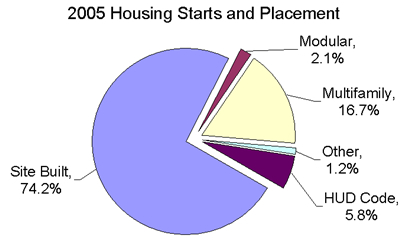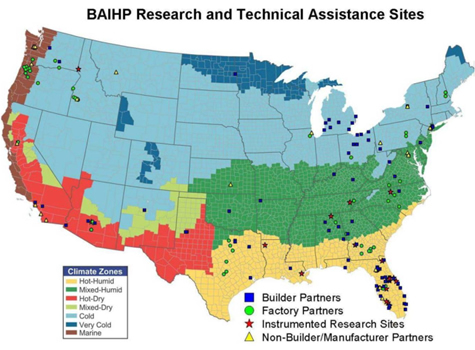


I. BAIHP Introduction
The Building America Industrialized Housing Partnership (BAIHP) team is the only university based Building America team competitively funded by the US Department of Energy, Office of Energy Efficiency and Renewable Energy-Building Technologies program.
BAIHP History
BAIHP began work on September 1, 1999 with a focus on improving energy efficiency, durability, and indoor air quality of new industrialized housing. DOE funding for the project has been supplemented by cost share funding from the Florida Energy Office (now defunct) of the Florida Department of Environmental Protection, the Northwest Energy Efficiency Alliance (NEEA), Florida Solar Energy Center (FSEC), and many Industry Partners. FSEC, a research institute of the University of Central Florida (UCF), serves as the project prime contractor.
Scope of this Report
This report aims to summarize the work performed during the entire project period of 9/1/1999 through 6/30/06 for a comprehensive account of the Building America Industrialized Housing Partnership (BAIHP) project. It describes in greater detail, the work performed during the last year of the contract, 4/1/05 through 6/30/06, as efforts prior to 4/1/05 are comprehensively documented in previous project annual reports. For the previous three annual reports, see:
BAIHP’s Goals
-
Cost effectively reduce the energy cost of industrialized housing and portable classrooms by up to 50% while enhancing indoor air quality, durability and productivity.
-
Assist in the construction of thousands of energy efficient industrialized houses annually.
-
Make our partners pleased and proud to be working with us.
BAIHP Team
The BAIHP team is the only university based Building America team competitively funded by the US Department of Energy, Office of Energy Efficiency and Renewable Energy-Building Technologies program. BAIHP began work on September 1, 1999 with a focus on improving energy efficiency, durability, and indoor air quality of new industrialized housing.
The BAIHP team is comprised of:
-
Florida Solar Energy Center (Lead)
-
Washington State University Energy Program (WSU)
-
University of Central Florida Industrial Engineering (UCFIE)
-
Florida Home and Energy Resources Organization (FL H.E.R.O.)
-
Calcs-Plus
In addition the American Lung Association, North Carolina A&T University, D.R.Wastchak, Oregon Dept. of Energy, Idaho Dept of Water Resources and the Blue Sky Foundation were subcontractors in prior years. The Florida Energy Office and the NorthWest Energy Efficiency Alliance provided cost share funding in the early years of the project.
 |
Figure
1. 2005 Census data shows 2.0683 million housing
starts (site built) and placements (manufactured) Note: Total exceeds 100%
because of disagreement among sources on total starts |
What is industrialized Housing?
Industrialized housing encompasses much of modern American construction including:
-
Manufactured Housing – factory-built to the nation wide HUD Code
-
Modular Housing - factory-built, site assembled modules meeting local code
-
Panelized/kit Housing – factory produced sub-assemblies put together on site to meet local codes
-
Production Housing - site-built systematically, factory built components
The project scope has also included portable classrooms during 2000-2002.
Of the two million homes built in the US in 2005 (Figure 1), approximately 6% were factory built to US Housing and Urban Development (HUD) code (U.S. Department of Commerce, 2003(a)(b) referred to as HUD Code Homes or Manufactured Homes. Manufactured Homes are one of the most affordable types of single-family detached housing available anywhere in the world, generally costing less than $35/ft2 plus land costs for centrally air conditioned and heated homes with built-in kitchens. Available in all parts of the country, manufactured homes are more popular in rural areas and in the southern and western US where land is still plentiful. Modular homes accounted for about 2% of 2005 housing starts. Many HUD Code home producers offer modular homes also which are built to local codes and take advantage of many factory production benefits.
Scope of BAIHP Activities
Within the larger context of the Building America program, BAIHP works to foster achievement of the Department of Energy’s goals. BAIHP researchers work in these areas:
-
Technical Assistance (Section I)
-
Field and Laboratory Research (Section II)
-
Training and Education (Section III)
-
Collaborations with the Homebuilding and Energy Industries (Section IV)
-
Project Management (Section V)
Industry Partnerships
BAIHP has partners in many stakeholder groups of the U.S. housing including HUD Code home manufacturers; modular, multifamily, and production site builders; product and material suppliers. Research organizations and other non-profits have worked with BAIHP to collaborate on field work, ventilation studies, ASHRAE committee work, and training. Partners receiving Technical Assistance for their projects are described Section II of this report. BAIHP Research efforts are described in Section III. Table 1 lists current and past BAIHP Project Industry Partners. The geographic distribution of our current partners is depicted on the map in Figure 2. Industry Partners list is kept updated at /partners/index.htm
Table 1. BAIHP Industry Partners (Present and Past)
HUD Code Home Manufacturers |
|
Cavalier Homes CAVCO Industries LLC Champion Homes (Redman) Champion Homes (Silvercrest) Clayton Homes Fleetwood Homes Fuqua Homes Golden West Homes Guerdon Enterprises Hi-Tech Homes Homark Homes Homebuilders North West |
Homes of Merit Karsten Company Kit Manufacturing Liberty Homes Marlette Homes Nashua Homes Oakwood Homes Palm Harbor Homes Skyline Corporation Southern Energy Homes Valley Manufactured Housing Western Homes |
Modular and Panelized Builders |
|
Avis America Homes Cardinal Homes Discovery Homes DuKane Precast Inc. Epoch Corporation Excel Homes General Homes |
Genesis Homes Nationwide Homes Penn Lyon Homes Royal Concrete Concepts The Homestore Trinity Construction Corp. |
Production Builders |
|
All America Homes American Energy Efficient Homes & Investments Inc. AMJ Construction Arvida Homes Atlantic Design and Construction Bobek Building Systems, Inc Cambridge Homes Centex Homes Dye Company DR Horton |
GMD Construction Co. G.W. Robinson Builder New Generation Homes by Kingon Inc. On Top of the World Patrick Family Housing, LLC Podia Construx Regents Park (Condominiums) Rey Homes Tommy Williams Homes WCI Communities Winton/Flair Homes |
Affordable Housing Builders |
|
East Dakota Housing Alliance City of Gainesville, FL City of Lubbock, TX City of Orlando, FL Habitat for Humanity International |
Homes in Partnership HKW Enterprises Miami-Dade Hope VI Project Sandspur Housing (Apartment builders) Williamsburg (townhouses) |
Custom Builders |
|
All America Homes of Gainesville, Inc. Energy Structures & Systems, Inc. Fallman Design and Construction L.F. Custom Homes Marquis Construction & Development, Inc. NatMax |
New Generation Homes by Kingon Inc. Pruett Builders, Inc. Scott Homes Spain Construction Stitt Energy Systems Timeless Construction |
Developers |
|
Castle & Cooke East Bay Development Company of FL LLC (Formerly Midgard Associates) |
Kashi Church Foundation, Inc. |
Research, Education, and Industry Association
Partners |
|
Auburn University School of Architecture Building Science Consortium Florida Green Building Coalition Florida International University, 2005 Solar Decathlon Team Florida Solar Energy Research and Education Foundation IBACOS, New American Home (Goehring Morgan Construction) Not-So-Big-House, (Sarah Susanka, AIA) |
Northwest Energy Efficient Manufactured Housing Program (NEEM) Pacific Northwest National Laboratory Portland Cement Association RADCO, Inc RESNET Structural Insulated Panel Association Stevens Associates (Home Ventilation Institute) Washington Manufactured Housing Assoc |
Industry Suppliers |
|
Allsolar Service Company Inc. Basement Systems, Inc. Bellview Air Beam Industries Classic Products Energy Conservatory Flexible Technologies GreenStone Industries |
Hard Cast Heat Pipe Technology Honeywell Icynene Inc. LaSalle Air Systems Minority Development Resource Group SSHC Inc. Style Crest Products Tamarack Technologies, Inc |
Figure 2. BAIHP research and technical assistance partner locations

Project Contact
Subrato Chandra,
BAIHP Project Director Florida Solar Energy Center 1679 Clearlake Rd, Cocoa, FL 32922 321- 638-1412 |
www.baihp.org www.fsec.ucf.edu subrato@fsec.ucf.edu |
BAIHP Home | Overview | Case Studies | Current Data
Partners | Presentations | Publications | Researchers | Contact Us
Copyright © 2002 Florida Solar Energy Center. All Rights Reserved.
Please address questions and comments regarding this web page to BAIHP Master